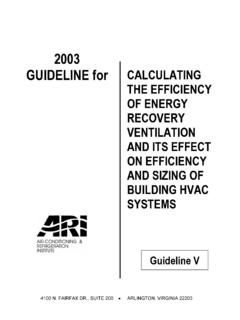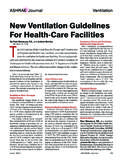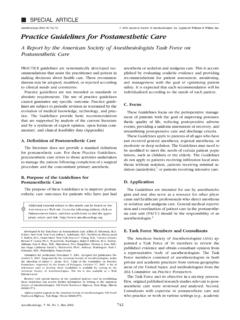Transcription of Energy Recovery Ventilators in Cold Climates - cchrc.org
1 Energy Recovery Ventilators in Cold Climates Robbin Garber-Slaght Vanessa Stevens Dustin Madden December 19, 2014. Cold Climate Housing Research Center Box 82489. Fairbanks, AK 99708. Telephone: Fax: Energy Recovery Ventilators in Cold Climates Cold Climate Housing Research Center Acknowledgements This report was produced with funding from the Alaska Housing Finance Corporation. CCHRC would also like to thank the homeowners who participated in the study. Table of Contents Abstract .. 3. Residential ventilation .. 4. HRVs and ERVs .. 5. ERV Basics .. 6. Frost Management 7.
2 Rating Systems .. 8. Literature Review .. 8. CCHRC Preliminary ERV Tests (Winter 2013-2014).. 9. Study Methods .. 9. Results and Analysis .. 11. 18. Conclusions .. 20. References .. 21. 2. Energy Recovery Ventilators in Cold Climates Abstract An Energy Recovery ventilator (ERV) is used to create a balanced ventilation system in residential and commercial buildings. ERVs bring in outside fresh air which is tempered with outgoing stale air. An ERV. recovers both heat and moisture from outgoing air in contrast to a heat Recovery ventilator (HRV) which recovers heat only.
3 Historically, HRVs have been used in cold Climates as ERVs have performed poorly in cold Climates with frosting failures. This study monitored eight ERVs installed in Fairbanks, Alaska to determine if flat plate Energy exchangers could perform in cold Climates without frosting failure. All eight units performed adequately over the course of the 2013-2014 winter. There were no observed instances of mechanical failure due to excessive frost in the systems, which may indicate that all of the units have adequate defrost strategies for use in cold Climates . Further research into the efficacy of ERVs at improving air indoor quality and their overall installed efficiency in cold Climates is suggested.
4 3. Energy Recovery Ventilators in Cold Climates Energy Recovery Ventilators in Cold Climates Maintaining healthy indoor air quality in cold Climates can be challenging due to the need for sufficient fresh air intake. Residential buildings in cold Climates have historically relied on air leakage through the building envelope to provide adequate ventilation . However, due to improved building techniques, mechanical ventilation may be necessary as building envelopes become tighter and as new construction seeks compliance with ventilation standards like ASHRAE The widely adopted best practice for providing mechanical ventilation in Alaska is through a Heat Recovery Ventilator (HRV) which brings in outside air by way of a heat exchanger that heats the supply air with the exiting air from the building.
5 An HRV tends to remove moisture from the inside of the house which is an important moisture control strategy in cold Climates . However, this moisture removal is often excessive, creating a very dry indoor climate that may cause occupant discomfort. This creates a conflict between providing adequate air exchange and a reasonable interior relative humidity (RH). Another ventilation option, common in more moderate and cooling-dominated Climates , is an Energy Recovery Ventilator (ERV) which is similar to an HRV but also allows for the Recovery of moisture from the exiting air.
6 Due to a limited number of ERVs installed in cold Climates , the technology in this environment is unproven. Typically people assume that they cannot be used because the Energy exchanger will develop frost at cold exterior temperatures. CCHRC conducted this study to gain a better understanding of how ERVs perform in cold Climates , particularly if they frost and fail to deliver tempered fresh air. The study found that the systems did not suffer mechanical failure from frost accumulation due to their adequate defrost strategies. Residential ventilation ventilation systems bring in fresh air and some systems even distribute it throughout a building.
7 Mechanical ventilation exhausts indoor pollutants such as volatile organic compounds (VOCs), cigarette smoke, cooking fumes, carbon dioxide, radon, and more. Some ventilation systems also have filters for incoming air, which can reduce concentrations of particulate matter such as pollen, dust, and combustion byproducts. All in all, ventilation systems help buildings maintain a healthy indoor air quality. The amount of ventilation needed by a home is specified by ASHRAE standard (2010). The standard sets a minimum whole house ventilation rate based on floor area and number of bedrooms.
8 For example, a 3 bedroom, 1500 square foot house should have 45cubic feet per minute (CFM) of fresh air delivered continuously. In Alaska a modified version of the ASHRAE standard, 55 CFM is required for a new building to meet the Building Energy Efficiency Standard (BEES) (Alaska Housing Finance Corporation, 2014). Dedicated ventilation systems are especially important in homes with low levels of air leakage due to tighter envelopes, since natural drafts through openings around windows and doors, or through wall materials, are not sufficient to meet indoor air quality requirements.
9 4. Energy Recovery Ventilators in Cold Climates There are four basic ventilation approaches: none, exhaust-only, supply, and balanced. The first is to not have a dedicated ventilation system at all. This was common when homes were not built as tightly as today, ventilation occurred through the leaky building envelope and windows. Unlike the other approaches, this approach has no control system. This strategy is still used today, supplemented by modern appliances that act as exhaust-only ventilation , such as clothes dryers and wood stoves. An exhaust-only system uses dedicated appliances, usually a range hood above the stove and exhaust fans in the bathroom, to exhaust air.
10 These appliances are controlled by on/off switches or timers but fresh air must enter a home through holes in the building envelope. An exhaust-only system that does not have make-up air holes in the building envelope can create negative pressure in the house and cause back drafting of combustion appliances. A supply system is the opposite of an exhaust-only system. In a supply system, a central fan is integrated with a forced air distribution system to provide fresh air to a home. During the heating season in Alaska, a supply-only system will pressurize a home, forcing warm air through leaks to the outside.







